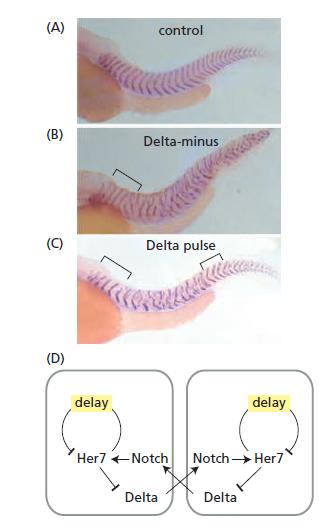The oscillatory clock that drives somite formation in vertebrates involves three essential components Her7 (an unstable repressor
Question:
The oscillatory clock that drives somite formation in vertebrates involves three essential components Her7 (an unstable repressor of its own synthesis), Delta (a transmembrane signaling molecule), and Notch (a transmembrane receptor for Delta). Notch is bound by Delta on neighboring cells, activating the Notch signaling pathway, which then activates Her7 transcription. Normally, this system works flawlessly to create sharply defined somites (Figure Q21–2A). In the absence of Delta, however, only the first five somites form normally, and the rest are poorly defined (Figure Q21–2B). If a pulse of Delta is supplied later, somite formation returns to normal in the regions where Delta was present (Figure Q21–2C). A diagram of the connections between the components of the clock and how they interact in adjacent cells is shown in Figure Q21–2D. In the absence of Delta, why do the cells become unsynchronized? What is it about the presence of Delta that keeps adjacent cells oscillating in synchrony?
Figure Q21-2

Step by Step Answer:

Molecular Biology Of The Cell
ISBN: 9780815344322
6th Edition
Authors: Bruce Alberts, Alexander D. Johnson, Julian Lewis, David Morgan, Martin Raff, Keith Roberts, Peter Walter





